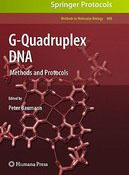G-quadruplex DNA - Methods and protocols

Submitted: 28 June 2010
Accepted: 28 June 2010
Published: 16 September 2010
Accepted: 28 June 2010
Abstract Views: 820
PDF: 370
HTML: 254
HTML: 254
Publisher's note
All claims expressed in this article are solely those of the authors and do not necessarily represent those of their affiliated organizations, or those of the publisher, the editors and the reviewers. Any product that may be evaluated in this article or claim that may be made by its manufacturer is not guaranteed or endorsed by the publisher.
All claims expressed in this article are solely those of the authors and do not necessarily represent those of their affiliated organizations, or those of the publisher, the editors and the reviewers. Any product that may be evaluated in this article or claim that may be made by its manufacturer is not guaranteed or endorsed by the publisher.

 https://doi.org/10.4081/1759
https://doi.org/10.4081/1759














